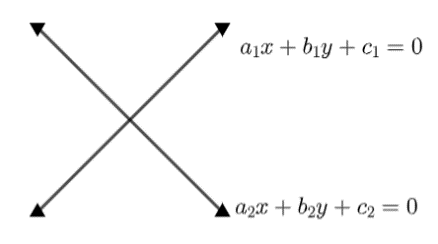
Select the correct option to complete the statement: ‘Two parallel lines have: ’
(a) a common point
(b) two common points
(c) no common point
(d) infinite common points
Answer
562.2k+ views
Hint: Understand the definitions of different types of lines such as parallel lines, intersecting lines and coincident lines. Observe their general equations and properties to determine the correct option.
Complete step by step answer:
Here, we have been provided with four options and we have to determine the correct one to complete the statement: - ‘Two parallel lines have: ‘. First, let us see the following different types of lines.
1. Intersecting lines: -
Two lines are called intersecting lines when they meet or cut each other at a particular point. The general equation of two intersecting lines can be given as: -
\[\Rightarrow {{a}_{1}}x+{{b}_{1}}y+{{c}_{1}}=0\] - (1)
\[\Rightarrow {{a}_{2}}x+{{b}_{2}}y+{{c}_{2}}=0\] - (2)
The figure shown below represents two intersecting lines.

Clearly, we can see that two intersecting lines have only one point in common.
2. Parallel lines: -
Two lines are called parallel lines of the distance between them remains constant throughout their extension in the infinite plane. The general equation of two parallel lines can be given as: -
\[\Rightarrow {{a}_{1}}x+{{b}_{1}}y+{{c}_{1}}=0\] - (1)
\[\Rightarrow {{a}_{2}}x+{{b}_{2}}y+{{c}_{2}}=0\] - (2)
The constant distance between these lines is \[\left| {{c}_{1}}-{{c}_{2}} \right|\]. Clearly, we can see that the slope of both the lines are equal. So, in general parallel lines have the same slope. The figure shown below represents two parallel lines.

Clearly, we can see that two parallel lines have no point in common.
3. Coincident lines: -
Two lines are called coincident lines if they overlap with each other. The general equation of two coincident lines can be given as: -
\[\Rightarrow ax+by+c=0\] - (1)
\[\Rightarrow k\left( ax+by+c \right)=0\] - (2)
Here, k is any constant.
The figure shown below represents two coincident lines: -

Clearly, we can see that two coincident lines have infinite common points.
Therefore, on reading the above three types of lines we come to the conclusion that ‘two parallel lines have no common point’.
So, the correct answer is “Option c”.
Note: One may note that to solve the above question we must know the definitions of different types of lines. Here, we have used their differences in properties as our main points. You must know the general equations of such types of lines so that in case you forget the definitions, these equations will help you to solve the problem.
Complete step by step answer:
Here, we have been provided with four options and we have to determine the correct one to complete the statement: - ‘Two parallel lines have: ‘. First, let us see the following different types of lines.
1. Intersecting lines: -
Two lines are called intersecting lines when they meet or cut each other at a particular point. The general equation of two intersecting lines can be given as: -
\[\Rightarrow {{a}_{1}}x+{{b}_{1}}y+{{c}_{1}}=0\] - (1)
\[\Rightarrow {{a}_{2}}x+{{b}_{2}}y+{{c}_{2}}=0\] - (2)
The figure shown below represents two intersecting lines.

Clearly, we can see that two intersecting lines have only one point in common.
2. Parallel lines: -
Two lines are called parallel lines of the distance between them remains constant throughout their extension in the infinite plane. The general equation of two parallel lines can be given as: -
\[\Rightarrow {{a}_{1}}x+{{b}_{1}}y+{{c}_{1}}=0\] - (1)
\[\Rightarrow {{a}_{2}}x+{{b}_{2}}y+{{c}_{2}}=0\] - (2)
The constant distance between these lines is \[\left| {{c}_{1}}-{{c}_{2}} \right|\]. Clearly, we can see that the slope of both the lines are equal. So, in general parallel lines have the same slope. The figure shown below represents two parallel lines.

Clearly, we can see that two parallel lines have no point in common.
3. Coincident lines: -
Two lines are called coincident lines if they overlap with each other. The general equation of two coincident lines can be given as: -
\[\Rightarrow ax+by+c=0\] - (1)
\[\Rightarrow k\left( ax+by+c \right)=0\] - (2)
Here, k is any constant.
The figure shown below represents two coincident lines: -

Clearly, we can see that two coincident lines have infinite common points.
Therefore, on reading the above three types of lines we come to the conclusion that ‘two parallel lines have no common point’.
So, the correct answer is “Option c”.
Note: One may note that to solve the above question we must know the definitions of different types of lines. Here, we have used their differences in properties as our main points. You must know the general equations of such types of lines so that in case you forget the definitions, these equations will help you to solve the problem.
Recently Updated Pages
Master Class 9 Social Science: Engaging Questions & Answers for Success

Master Class 9 Science: Engaging Questions & Answers for Success

Master Class 9 English: Engaging Questions & Answers for Success

Master Class 9 Maths: Engaging Questions & Answers for Success

Master Class 9 General Knowledge: Engaging Questions & Answers for Success

Class 9 Question and Answer - Your Ultimate Solutions Guide

Trending doubts
Difference Between Plant Cell and Animal Cell

What is the Full Form of ISI and RAW

What is the difference between Atleast and Atmost in class 9 maths CBSE

Distinguish between Conventional and nonconventional class 9 social science CBSE

What is chronic hunger and seasonal hunger

Define development




